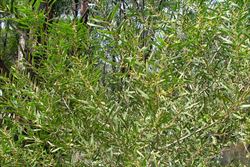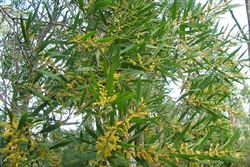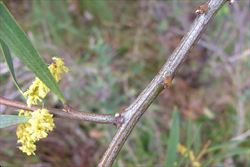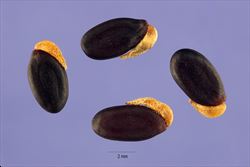Click on images to enlarge

habit (Photo: Sheldon Navie)

habit (Photo: Sheldon Navie)

close-up of younger branch (Photo: Sheldon Navie)

branches with numerous elongated flower clusters (Photo: Sheldon Navie)

elongated flower clusters (Photo: Jackie Miles and Max Campbell)

close-up of seeds with small fleshy arils (Photo: Steve Hurst at USDA PLANTS Database)
Scientific Name
Acacia longifolia (Andrews) Willd. subsp. longifolia
Note: Acacia longifolia (Andrews) Willd. is currently used in Queensland.
Synonyms
Acacia latifolia hort.Acacia longifolia (Andrews) Willd.Acacia longifolia (Andrews) Willd. var. latifolia SweetAcacia longifolia (Andrews) Willd. var. longifoliaAcacia longifolia (Andrews) Willd. var. typica Benth.Mimosa longifolia AndrewsMimosa macrostachya Poir. Phyllodoce longifolia (Andrews) LinkRacosperma longifolium (Andrews) C. Mart.
Family
Fabaceae: sub-family Mimosoideae (New South Wales)Leguminosae (South Australia)Mimosaceae (Queensland, the ACT, Victoria, Tasmania, Western Australia and the Northern Territory)
Common Names
golden rods, golden wattle, long-leaved acacia, long leaved wattle, long-leaf wattle, long-leaved wattle, sallow wattle, Sydney golden wattle, Sydney wattle
Origin
Sydney golden wattle (Acacia longifolia subsp. longifolia) is native to many parts of south-eastern Australia. Natural populations occur in eastern New South Wales and eastern Victoria (and possibly also in south-eastern Queensland). In New South Wales it is mainly found south of the Kempsey and Torrington districts, however there is also an isolated occurrence in the Tenterfield district in northern New South Wales. In Victoria it is thought to be native to the East Gippsland area. However, its original distribution in Victoria is uncertain, due to widespread cultivation there for many years.
Cultivation
Because of its fast growth rate and abundant bright yellow flowers, this species has been very widely cultivated outside its native range, particularly in southern Australia.
Naturalised Distribution
Naturalised in south-western Western Australia, between Perth and Albany, and in south-eastern South Australia. It is possibly also becoming naturalised in other parts of South Australia (i.e. on the Eyre Peninsula and on Kangaroo Island). Also widely naturalised beyond its native range in many parts of southern, central and western Victoria. Sydney golden wattle (Acacia longifolia subsp. longifolia) is also known to be naturalised in Tasmania.
A few collections of this plant have also been made in the Moreton district of south-eastern Queensland, but probably represent natural populations.
Sydney golden wattle (Acacia longifolia subsp. longifolia) and has also become naturalised in southern Africa, New Zealand, Colombia, Uruguay, Argentina, Indonesia, Israel, Spain, Portugal, Mauritius and in California in the USA.
Habitat
Sydney golden wattle (Acacia longifolia subsp. longifolia) grows naturally in a wide range of communities including heathlands, woodlands and tall forests. Within these communities it is often found growing along creeks, near swamps or in disturbed sites. Where both plants occur together, Sydney golden wattle (Acacia longifolia subsp. longifolia) usually occurs more towards the hinterlands of coastal districts and is generally replaced by coastal wattle (Acacia longifolia subsp. sophorae ) nearer to the sea. However, in some localities the two sub-species appear to grade almost imperceptively into one another.
In areas where it has become naturalised in Australia, Sydney golden wattle (Acacia longifolia subsp. longifolia) grows on roadsides, along watercourses, in swamps and in native bushland.
In South Africa it grows in fynbos shrublands, woodlands and along watercourses, while in California it grows in disturbed places in sandy coastal areas.
Habit
An upright (i.e. erect) and spreading shrub or small tree usually growing 1-8 m tall, but occasionally reaching up to 10 m in height.
Distinguishing Features
- a shrub or small tree with simple 'leaves' that are bright green or dark green in colour.
- its 'leaves' are elongated to linear in shape (i.e. more than six times longer than wide) and gradually narrow to a somewhat pointed tip.
- its yellow or golden yellow flowers are densely arranged in elongated clusters (25-50 mm long), one or two of which are borne in each 'leaf' fork.
- its elongated and cylindrical pods (4-15 cm long) are straight or slightly curved and slightly constricted between each of the seeds.
Stems and Leaves
The bark on older stems is greyish in colour and either smooth or finely fissured. Younger branches are green or reddish-green in colour and angled towards their tips. These branches are either hairless (i.e. glabrous) or sparsely covered in close-lying (i.e. appressed) hairs.
The 'leaves' of this plant are actually flattened and widened leaf stalks (i.e. petioles), and not leaves in the true sense of the word. These modified leaf stalks are called phyllodes, but serve the same function as a regular leaf. On very young plants, partially formed phyllodes can be seen which bear twice-compound (i.e. bipinnate) leaves at their tips. As the seedling grows, each new 'leaf' has phyllodes that are more fully formed and the leaves at their tips become reduced and eventually vanish altogether. The phyllodes are alternately arranged along the stems, elongated to linear in shape (5-25 cm long and 4-20 mm wide), and generally more than six times longer than they are broad. They are straight or occasionally slightly curved, mostly hairless (i.e. glabrous), and usually bright green or dark green in colour. They are also relatively thin and pliable and have pointed or somewhat pointed tips (i.e. acute or sub-acute apices). There are 2-4 prominent parallel veins that run the length of each of the phyllodes, and where each phyllode joins to the stem there is a short thickened structure (i.e. a pulvinus) 3-5 mm long which can be easily confused for a leaf stalk (i.e. petiole). Near the base of the phyllode (i.e. 2-10 mm above the pulvinus), there is a usually a small indentation or raised structure (i.e. a gland) on the phyllode margin.
Flowers and Fruit
The small yellow or golden-yellow flowers are stalkless (i.e. sessile) and densely arranged in elongated clusters (20-50 mm long and about 7 mm wide). These flowers each have four relatively inconspicuous petals and sepals and numerous conspicuous stamens that give them a very fluffy appearance.The elongated flower clusters (i.e. spikes) are stalkless or have very short stalks that are less than 2 mm long (i.e. they are sessile or sub-sessile). These flower clusters emanate from the forks (i.e. axils) of the upper leaves and one or two may be present in each leaf fork. Flowering occurs mainly during winter and early spring (i.e. from June to October).
The fruit is a very elongated pod (40-150 mm long and 3-10 mm wide) that is cylindrical or almost cylindrical in shape with a pointed tip. These pods are sometimes constricted between each of the seeds and are either hairless or sparsely hairy (i.e. glabrous or puberulent). They are usually straight or slightly curved in nature, but they may sometimes become curled back or twisted after opening. The pods are initially green in colour but turn brown as they mature and are normally present during summer (i.e. from December to January). Each pod cotains 4-10 black seeds that are oval (i.e. elliptic) in shape. These seeds (4-5 mm long and 3-4 mm wide) are smooth in texture and shiny in appearance. They have a large, orange, fleshy, cup-shaped structure (i.e. an aril) attached to them.
Reproduction and Dispersal
Reproduction in this species is entirely by seed. However, young plants often reshoot vigorously from their bases after fire or other damage.
The seeds may be dispersed by animals such as ants and birds. They may also be spread by human activities such as slashing, and in dumped garden waste and contaminated soil.
Environmental Impact
Sydney golden wattle (Acacia longifolia subsp. longifolia) is regarded as a significant environmental weed in some parts of Victoria and is also a relatively important environmental weed in South Australia and Western Australia. It has generally become naturalised after escaping from gardens and other deliberate plantings and has been found to be highly invasive in some areas.
In Victoria it poses a significant threat outside its natural range and has invaded heathlands, woodlands and forests. In heathlands, where it is particularly troublesome, it can form dense stands that smother all of the indigenous vegetation (i.e. shade out low-growing plants and crowd out shrubs). Because of this it has been classified as an environmental weed in the Port Phillip, North Central and Goulbourn Broken Catchment and Land Protection regions of Victoria.
In South Australia it is regarded as a common environmental weed in the Adelaide region and invades bushland near urban areas (e.g. it is well established as a weed in the nearby Mount Lofty Ranges). It was first recorded in South Australia in 1963 in the Penola Forest in the far south-east of the state near the Victorian border. It is now widely distributed in this region, including in the Caroline Forest area, the Mt Burr area and the Penola/Comaum area.
In south-western Western Australia Sydney golden wattle (Acacia longifolia subsp. longifolia ) is a weed of roadsides, creeks and swamps and is also invading bushland around Albany. It is listed as a moderately important environmental weed in the Environmental Weed Strategy of Western Australia and is one of fifteen priority environmental weeds in the Albany region. Bushcare Tasmania also lists this plant as one of four introduced wattles that are weeds in Tasmania's bushland areas.
Sydney golden wattle (Acacia longifolia subsp. longifolia) can fix nitrogen and alter the nutrient balance of the soil, like other acacias. Therefore, dense stands of this species may increase soil fertility to the point where the growth and regeneration of some indigenous species will be inhibited or prevented. The long-lived seeds of this species are stimulated to germinate by fire and very dense populations can follow fires, particularly where the indigenous vegetation has been removed or significantly disturbed.
In South Africa, where this species invades fynbos shrublands, woodlands and watercourses, it is also regarded as a very important environmental weed.
Legislation
Sydney golden wattle (Acacia longifolia subsp. longifolia) is not declared or considered noxious by any state or territory government in Australia.
Management
For information on the management of this species see the following resources:
- the Weeds in your Bush section of the Tasmanian Bushcare Toolkit which is available online at http://www.dpiw.tas.gov.au.
- the Woody Weeds Information Pamphlet on the Environmental Weeds Action Network (EWAN) website at http://members.iinet.net.au/~ewan/.
- Muyt (2001), Bush Invaders of South-east Australia, pp. 156-158.
- Moore and Wheeler (2002), Southern Weeds and their Control, pp. 134-140.
Similar Species
Sydney golden wattle (Acacia longifolia subsp. longifolia) is very similar to coastal wattle (Acacia longifolia subsp. sophorae). Typical individuals of these two plants can be distinguished by the following differences:
- Sydney golden wattle (Acacia longifolia subsp. longifolia) is a more upright shrub growing up to 10 m tall. Its 'leaves' (i.e. phyllodes) are relatively long and narrow (5-25 cm long and 4-20 mm wide) and usually more than six times longer than they are wide. These 'leaves' are usually relatively thin and pliable in nature and narrow gradually to pointed or somewhat pointed tips (i.e. acute or sub-acute apices). The pods are straight or slightly curved when young , but may become curled back or slightly twisted after opening.
- coastal wattle (Acacia longifolia subsp. sophorae) is a low-growing shrub usually 0.5-3 m tall. Its 'leaves' (i.e. phyllodes) are relatively short and broad (4-12 cm long and 10-35 mm wide) and usually less than five times longer than they are wide. These 'leaves' are usually relatively thick and leathery in nature and narrow abruptly to rounded or somewhat pointed tips (i.e. obtuse or slightly mucronate apices). The pods are curved or coiled when young and become very contorted or twisted after opening.
Note: Hybrids of Sydney golden wattle (Acacia longifolia subsp. longifolia) and coastal wattle (Acacia longifolia subsp. sophorae) are thought to occur naturally where the two plants grow together. Such hybrid plants display characters that are intermediate between the two parent plants. Therefore, this can often make it difficult to determine whether particular specimens are Sydney golden wattle (Acacia longifolia susbp. longifolia), coastal wattle (Acacia longifolia subsp. sophorae), or an intermediate hybrid of the two.
Sydney golden wattle (Acacia longifolia subsp. longifolia) is also very similar to stiff-leaved wattle (Acacia obtusifolia) and a naturally occurring hybrid between coastal wattle (Acacia longifolia subsp. sophorae) and spike wattle (Acacia oxycedrus). Stiff-leaved wattle (Acacia obtusifolia) can be differentiated by its rounded (i.e. obtuse) 'leaf' tips and that fact that it flowers during late spring and summer (i.e. from November to January). Acacia oxycedrus x Acacia longifolia subsp. sophorae has somewhat hairy stems and its 'leaves' (i.e. phyllodes) are quite rigid in nature with sharply to coarsely pointed tips (i.e. pungent apices).
This page only covers those species that have been reported to be commonly confused with Sydney golden wattle (Acacia longifolia subsp. longifolia). For a more in-depth key to all of wattle (Acacia spp.) present in Australia, see the Wattle: Acacias of Australia CD-ROM or Flora of Australia, Volumes 11A and 11B.

